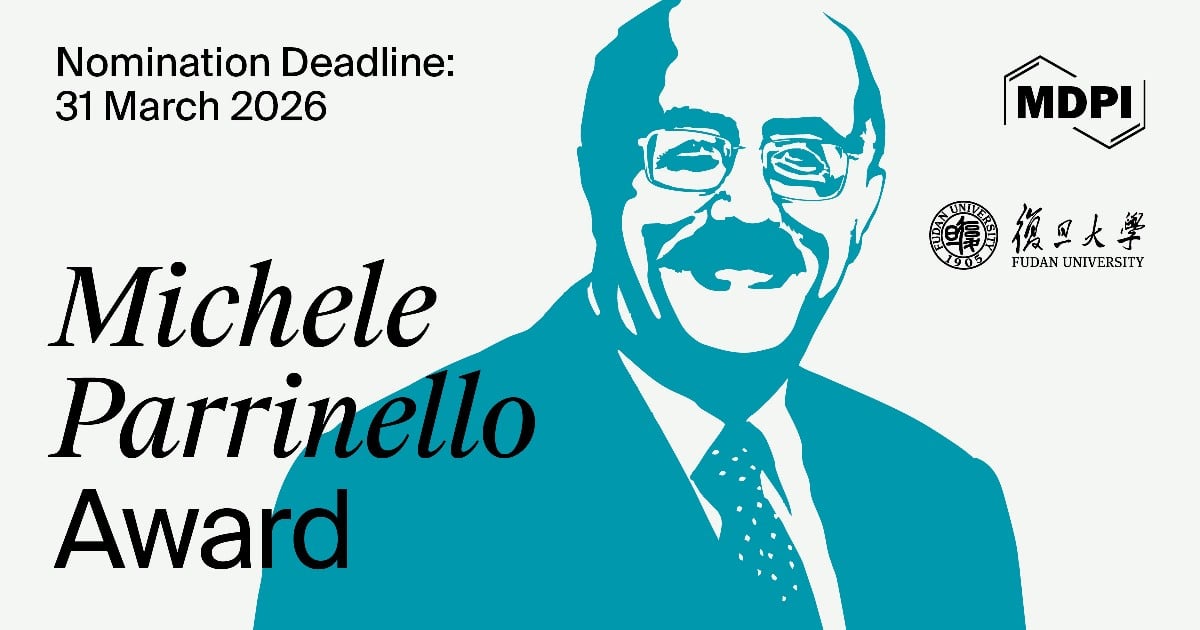-
 Identification and Characterization of MmuPV1 Causing Papillomatosis Outbreak in an Animal Research Facility
Identification and Characterization of MmuPV1 Causing Papillomatosis Outbreak in an Animal Research Facility -
 Potential for Core Fucose-Targeted Therapy Against HBV Infection of Human Normal Hepatocytes
Potential for Core Fucose-Targeted Therapy Against HBV Infection of Human Normal Hepatocytes -
 Broadly Sarbecovirus-Neutralizing Antibodies Induced by Ancestral SARS-CoV-2 Infection
Broadly Sarbecovirus-Neutralizing Antibodies Induced by Ancestral SARS-CoV-2 Infection -
 Dysregulation of microRNAs in the Brains of Mice Infected with Powassan Virus
Dysregulation of microRNAs in the Brains of Mice Infected with Powassan Virus -
 Immune Responses and Replication of Rescued Torque Teno Virus (TTSuV1) in Mice
Immune Responses and Replication of Rescued Torque Teno Virus (TTSuV1) in Mice
Journal Description
Viruses
Viruses
is a peer-reviewed, open access journal of virology, published monthly online by MDPI. The Spanish Society for Virology (SEV), Canadian Society for Virology (CSV), Italian Society for Virology (SIV-ISV), Australasian Virology Society (AVS), Brazilian Society for Virology (BSV) and others are affiliated with Viruses and their members receive a discount on the article processing charges.
- Open Access— free for readers, with article processing charges (APC) paid by authors or their institutions.
- High Visibility: indexed within Scopus, SCIE (Web of Science), PubMed, MEDLINE, PMC, Embase, PubAg, and other databases.
- Journal Rank: JCR - Q2 (Virology) / CiteScore - Q1 (Virology/Infectious Diseases)
- Rapid Publication: manuscripts are peer-reviewed and a first decision is provided to authors approximately 18.6 days after submission; acceptance to publication is undertaken in 2.5 days (median values for papers published in this journal in the first half of 2025).
- Recognition of Reviewers: reviewers who provide timely, thorough peer-review reports receive vouchers entitling them to a discount on the APC of their next publication in any MDPI journal, in appreciation of the work done.
- Companion journal: Zoonotic Diseases.
Impact Factor:
3.5 (2024);
5-Year Impact Factor:
3.7 (2024)
Latest Articles
Innovative Nurse-Led Community Health Centre–Corrections Partnership for Hepatitis C Testing and Treatment in Victoria, British Columbia
Viruses 2025, 17(12), 1590; https://doi.org/10.3390/v17121590 (registering DOI) - 6 Dec 2025
Abstract
People who are incarcerated experience a high rate of hepatitis C (HCV) worldwide, and HCV micro-elimination in prisons is an effective strategy to support treatment. In Victoria, British Columbia, administrative barriers limited HCV testing and treatment at Vancouver Island Correctional Centre (VIRCC), and
[...] Read more.
People who are incarcerated experience a high rate of hepatitis C (HCV) worldwide, and HCV micro-elimination in prisons is an effective strategy to support treatment. In Victoria, British Columbia, administrative barriers limited HCV testing and treatment at Vancouver Island Correctional Centre (VIRCC), and people who were HCV RNA+ were lost to follow up. Cool Aid Community Health Centre (CACHC) is an inner-city, primary care clinic that serves a marginalized population. The CACHC HCV nurse coordinator with the VIRCC nurse held HCV testing ‘blitzes’ at VIRCC and offered phlebotomy for screening and pre-treatment bloodwork. Clients who tested HCV RNA+ were started on HCV treatment and if discharged before completion, CACHC followed them in the community. A retrospective chart review was conducted to identify all clients who accessed HCV testing and treatment through the VIRCC partnership. To date, 230 clients were tested: 49 tested HCV antibody+, 11 tested HCV RNA+, and 10 started on treatment (6 SVR). Case management and consultation with the nurse coordinator and VIRCC nurse supported treatment starts for an additional 18 clients (14 SVR). This pragmatic and innovative approach to HCV care with people who are incarcerated demonstrated effective HCV testing and treatment. CACHC and VIRCC have established closer relationships and reduced barriers to reach and maintain continuity with this target population.
Full article
(This article belongs to the Special Issue Advancing Hepatitis Elimination: HBV, HDV, and HCV)
►
Show Figures
Open AccessProject Report
Getting to the Point: A Community-Designed, Low-Barrier Hepatitis C Testing and Treatment Program for People Who Inject Drugs in Rural America
by
Amanda N. Perry, Elizabeth Eccles, Shoshana H. Bardach, Alastair Huntley, Ryan Fowler and David de Gijsel
Viruses 2025, 17(12), 1589; https://doi.org/10.3390/v17121589 (registering DOI) - 6 Dec 2025
Abstract
Background: People who inject drugs (PWID) have a higher risk of contracting hepatitis C (HCV) than the general population, but these individuals are often poorly served by traditional healthcare systems. The elimination of HCV as a threat to public health relies on the
[...] Read more.
Background: People who inject drugs (PWID) have a higher risk of contracting hepatitis C (HCV) than the general population, but these individuals are often poorly served by traditional healthcare systems. The elimination of HCV as a threat to public health relies on the treatment of this population. Novel care models designed with input from PWID may help to better align care to the needs of PWID. Methods: We designed and implemented a community-based, point-of-care testing program for HCV delivered by a syringe service program, combined with facilitated access to a healthcare provider, care navigation, and financial incentives. We collected participant demographics and drug use patterns, testing and treatment history, and communication preferences. Descriptive analyses include the number of people tested between 15 October 2021 and 1 February 2025, their seropositivity rate, and the number who completed pre-treatment laboratory tests, completed treatment and achieved cure by sustained virologic response (SVR12) by 1 August 2025. Results: The program engaged 464 unique individuals, of whom 98 (21.1%) had a known diagnosis of HCV. Of 389 unique individuals who underwent point of care (POC) HCV antibody (Ab) testing, including 31 with a known prior diagnosis of HCV, 97 (24.9%) had a positive result. Of 439 unique individuals who underwent POC HIV Ab testing, only 1 had a positive result. Of 164 individuals with either a positive POC HCV Ab test or a known HCV diagnosis, 66 completed pre-treatment laboratory tests, identifying 52 viremic participants. Of those, 35 started and completed treatment. Among those who completed treatment, 9 (25.7%) achieved SVR12, 3 (8.6) failed to achieve SVR12, and 23 (65.7%) had outstanding laboratory orders for SVR12 determination. Conclusions: An incentivized, community-based, point-of-care testing program with facilitated linkage to care successfully engaged a high-risk population in HCV and HIV testing and treatment. However, substantial attrition occurred at each step of the care cascade, particularly at SVR12 determination. Additional strategies are needed to optimize retention throughout the entire care cascade.
Full article
(This article belongs to the Special Issue Hepatitis C Virus Infection among People Who Inject Drugs)
►▼
Show Figures

Figure 1
Open AccessReview
CRISPR Treatments for AI-Designed Synthetic Viruses: Rapid Programmable Countermeasures for Emerging and Engineered Viruses
by
Douglas P. Gladue and Alison O’Mahony
Viruses 2025, 17(12), 1588; https://doi.org/10.3390/v17121588 - 5 Dec 2025
Abstract
The convergence of artificial intelligence and synthetic biology is innovating and accelerating the design of novel viral genomes, expanding both therapeutic opportunities and dual-use risk. This review articulates a countermeasure strategy for emerging and engineered viruses leveraging the programmable CRISPR modality. Building on
[...] Read more.
The convergence of artificial intelligence and synthetic biology is innovating and accelerating the design of novel viral genomes, expanding both therapeutic opportunities and dual-use risk. This review articulates a countermeasure strategy for emerging and engineered viruses leveraging the programmable CRISPR modality. Building on mounting in vitro and in vivo evidence that Cas9 degrades DNA viruses (e.g., Orthopoxviruses, HSV-1, ASFV), while Cas13 targets RNA viral genomes (e.g., Influenza A, Dengue, RSV), both leading to reduced viremia, diminished disease burden, and alleviated symptoms. Here, we outline a rapid-response pipeline to position CRISPR-based countermeasures in translational and pandemic-response frameworks, linking real-time sequencing to AI-assisted gRNA selection and multiplexed cassette design to achieve viral targeting efficacy. To minimize resistance and off-target risk, we emphasize multi-gRNA cocktails, continuous genomic surveillance, and adaptive gRNA rotation. We also propose governance mechanisms, such as pre-cleared gRNA repositories, transparent design logs, standardized off-target/safety screening, and alignment with evolving nucleic-acid-synthesis screening frameworks to enable emergency deployment while preserving security. Furthermore, compressing the time from sequence to treatment and complementary to vaccines and small-molecule antivirals, CRISPR represents a technologically agile and strategically essential capability to combat both natural outbreaks and AI-enabled biothreats. Collectively, programmable CRISPR antivirals represent an auditable, rapidly adaptable foundation for next-generation biodefense preparedness.
Full article
(This article belongs to the Section General Virology)
Open AccessArticle
Genetic Association Between TMPRSS2 Polymorphisms and COVID-19 Severity in Brazilian Health Workers
by
Alysson Fellipe Costa Telles, Bearli Souza Menezes Junior, Cliomar Alves dos Santos, Maria Rosa Melo Alves, Ludmila Oliveira Carvalho Sena and Rosana Cipolotti
Viruses 2025, 17(12), 1587; https://doi.org/10.3390/v17121587 - 5 Dec 2025
Abstract
The diversity of clinical presentations and outcomes of COVID-19 suggests the influence of host-intrinsic factors that modulate the infectious process. Therefore, a study was conducted with professionals from a hospital in the state of Sergipe, in the Northeast region of Brazil, aiming to
[...] Read more.
The diversity of clinical presentations and outcomes of COVID-19 suggests the influence of host-intrinsic factors that modulate the infectious process. Therefore, a study was conducted with professionals from a hospital in the state of Sergipe, in the Northeast region of Brazil, aiming to identify in this population the effect of rs12329760 and rs2070788, SNPs of the TMPRSS2 enzyme that facilitates the infectious process. Recruitment of the 363 participants followed a non-probabilistic method using a QR code that led to the Informed Consent Form (ICF) and a clinical–epidemiological questionnaire based on self-reported information on the number of positive tests, the presence/absence of symptoms, and severity. Buccal epithelial cells were collected, DNA was extracted using a silica column, and SNP amplification was performed by qPCR. The data were processed using PSPP software, using chi-squared tests for associations in three statistical genetic models (additive, dominant, and recessive). The results showed that, in this population, rs12329760 did not influence any of the outcomes, while rs2070788 was significant in both the additive and recessive models. The action of the G allele is evident in the most severe cases, and it is associated with increased TMPRSS2 expression and potentially increased viral entry efficiency.
Full article
(This article belongs to the Section Coronaviruses)
►▼
Show Figures

Figure 1
Open AccessArticle
Epidemiological Surveys of Yam Fields in Côte d’Ivoire Revealed the First Detection of YMMV and Evidence of Episomal Badnavirus
by
Maïmouna M. Koné, Justin S. Pita, Cyrielle Ndougonna, Daniel H. Otron, Mariam Combala, Guy R. Eboulem, William J.-L. Amoakon, Bekanvié S. M. Kouakou, Angela O. Eni, Fatogoma Sorho and Fidèle Tiendrébéogo
Viruses 2025, 17(12), 1586; https://doi.org/10.3390/v17121586 - 5 Dec 2025
Abstract
Yam (Dioscorea spp.) is a major staple food, contributing significantly to food security and income generation for millions of people worldwide. In 2019, surveys were conducted across the seven agro-ecological zones (AEZs) of Côte d’Ivoire, the third highest producer of yam globally,
[...] Read more.
Yam (Dioscorea spp.) is a major staple food, contributing significantly to food security and income generation for millions of people worldwide. In 2019, surveys were conducted across the seven agro-ecological zones (AEZs) of Côte d’Ivoire, the third highest producer of yam globally, to ascertain the current status of viral diseases. In the 324 fields surveyed, a total of 1242 yam leaf samples were collected and tested for the presence of Potyvirus yamtesselati (yam mosaic virus, YMV), Potyvirus yamplacidum (yam mild mosaic virus, YMMV), Cucumovirus CMV (cucumber mosaic virus, CMV), and the badnaviruses using PCR, RT-PCR, and RCA followed by Sanger or MinION sequencing. The incidence of yam viral disease varied across the AEZs, with the lowest mean incidence observed in yam farms within the AEZ VII (71.95%) and the highest in AEZ V (88.15%). Viral disease symptom severity was moderate across the country, with more severe symptoms identified in AEZs II and VI. The virus screening revealed a potyvirus detection rate of 35.83% in all the AEZs. YMMV infection (25.12%) is the most prevalent in the samples, followed by YMV infection (15.61%). RCA-MinION sequencing revealed the presence of badnaviruses belonging to the T15 episomal groups K8, K9, and K5. Also, the use of this technique enabled the amplification and sequencing of four full-length episomal badnaviruses, namely Dioscorea bacilliform AL virus in group K8 and Dioscorea bacilliform RT virus in group K5. CMV was not detected in all the samples. It is noteworthy that 22.13% of mixed infections were detected in asymptomatic samples. This study revealed the first occurrence of YMMV in all the AEZs of Côte d’Ivoire. Of the yam species, Dioscorea alata was more widespread (78.03%) than Dioscorea cayenensis-rotundata (21.92%) in the visited fields. Also, D. alata had a highest incidence of YMMV (23.67%) infection than Dioscorea cayenensis-rotundata, while D. cayenensis-rotundata registered the highest incidence of YMV (15.84%) infection compared to D. alata. Phylogenetic analysis of representative of the various viruses detected in the country revealed that the sequences have high diversity for each virus species. This study revealed that viruses infecting yam are widespread and occur in mixed infection, which poses a real threat to yam production in Côte d’Ivoire.
Full article
(This article belongs to the Special Issue Economically Important Viruses in African Crops)
►▼
Show Figures
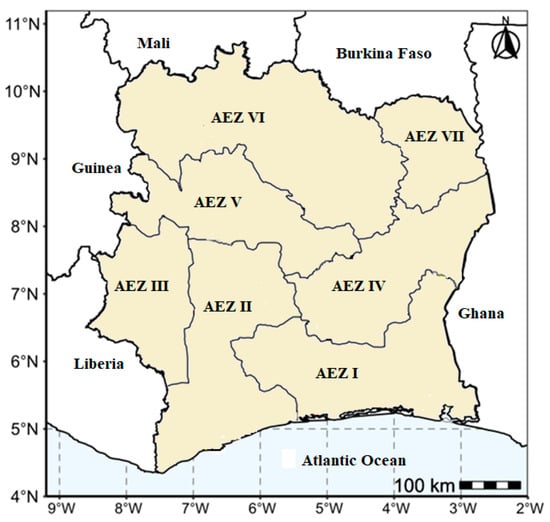
Figure 1
Open AccessArticle
Prevalence of Antibodies to Japanese Encephalitis Virus and Severe Fever with Thrombocytopenia Syndrome Virus in Wild Boars Captured Across Different Locations in Toyama Prefecture, Japan
by
Shunsuke Yazawa, Kotoha Yoshida, Kotaro Fujii, Yumiko Saga, Sara Taniguchi, Ryosuke Suzuki, Chang-Kweng Lim, Miki Ishida, Kazunori Oishi and Hideki Tani
Viruses 2025, 17(12), 1585; https://doi.org/10.3390/v17121585 - 5 Dec 2025
Abstract
Wild boars inhabit fields, hills, and farms across Japan, where they are fed on by numerous arthropods, including mosquitoes and ticks. Consequently, they are frequently exposed to arthropod-borne pathogens. In Toyama Prefecture, blood samples from captured wild boars have long been collected for
[...] Read more.
Wild boars inhabit fields, hills, and farms across Japan, where they are fed on by numerous arthropods, including mosquitoes and ticks. Consequently, they are frequently exposed to arthropod-borne pathogens. In Toyama Prefecture, blood samples from captured wild boars have long been collected for classical swine fever virus antibody testing, with detailed records kept on the capture locations. In this study, we investigated the prevalence of antibodies against Japanese encephalitis virus (JEV) and severe fever with thrombocytopenia syndrome virus (SFTSV) using 3059 serum samples collected from wild boars over the past six years. A previously developed single-round infectious particles (SRIPs) assay system was employed for the analysis. We also examined the geographic distribution of antibody-positive wild boars. The results showed that antibody positivity rates for both JEV and SFTSV increased annually from 2019 to 2024. Geographical analysis revealed that JEV antibody-positive wild boars were distributed throughout Toyama Prefecture, whereas SFTSV antibody-positive wild boars were concentrated mainly in the northwestern region and along the western prefectural border. These findings suggest that JEV continue to pose an infection risk across the entire prefecture, while SFTSV has been actively spreading in the northwestern area during 2023–2024, raising concern over an increasing risk of human infection.
Full article
(This article belongs to the Special Issue Severe Fever with Thrombocytopenia Syndrome Virus 2025)
►▼
Show Figures

Figure 1
Open AccessArticle
Timely Association of RSV Hospitalisation Waves in Children with the Detection of SARS-CoV-2 in the General Population in Eastern Bavaria
by
Alexander Kiefer, Andreas Ambrosch, Benedikt M. J. Lampl, Fritz Schneble, Kai Rubarth, Stefan Vlaho, Matthias Keller and Michael Kabesch
Viruses 2025, 17(12), 1584; https://doi.org/10.3390/v17121584 - 5 Dec 2025
Abstract
Background: The Respiratory Syncytial Virus (RSV) season of 2023/2024 was conspicuously different from previous seasons, with an abrupt decrease in hospitalisation rates at the peak of the season, leading to two lower peaks instead of the expected one high peak of hospitalisations. Thus,
[...] Read more.
Background: The Respiratory Syncytial Virus (RSV) season of 2023/2024 was conspicuously different from previous seasons, with an abrupt decrease in hospitalisation rates at the peak of the season, leading to two lower peaks instead of the expected one high peak of hospitalisations. Thus, we investigated whether there was an interference with other virus infection waves in the course of that RSV season. Methods: We analysed RSV seasons since 2016 in children who were hospitalised due to an RSV infection in Eastern Bavaria and investigated epidemiological features of RSV seasons after the severe acute respiratory syndrome coronavirus 2 (SARS-CoV-2) pandemic at local, regional, and national levels. Results: Analysing patterns of four RSV seasons prior to and three seasons after the SARS-CoV-2 pandemic, we found that the paediatric RSV hospitalisation wave of the 2023/2024 season was weaker and less pronounced than expected. When we compared detailed local, regional, and national surveillance data of other viral infections, we found that paediatric RSV hospitalisation waves were anticyclical to SARS-CoV-2 infection waves, but not to rhinovirus or influenza waves in the general population. Discussion: Our data suggests that concomitant SARS-CoV-2 infection waves in the general population may disrupt infection chains of RSV in children and, thus, decrease RSV-associated hospitalisation. This factor should be taken into account when assessing the effects of the upcoming RSV prophylaxis in the future.
Full article
(This article belongs to the Special Issue RSV Epidemiological Surveillance: 2nd Edition)
►▼
Show Figures
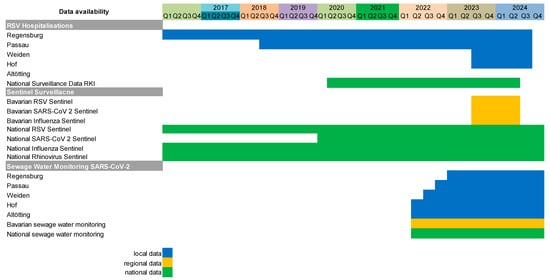
Figure 1
Open AccessArticle
In Vitro Evaluation of the Antiviral Effect of Spirulina maxima (Arthrospira) Alga Against Chikungunya Virus
by
José Angel Santiago-Cruz, Araceli Posadas-Mondragón, José Leopoldo Aguilar-Faisal, Cesar Ismael Ortiz-García, Danai Montalvan-Sorrosa, Norma Estela Herrera-González and Angélica Pérez-Juárez
Viruses 2025, 17(12), 1583; https://doi.org/10.3390/v17121583 - 5 Dec 2025
Abstract
Chikungunya fever (CHIKV) has reemerged as a serious global health problem worldwide. Currently, no antiviral drugs are available for the prevention or treatment of CHIKV infection. Therefore, this study aimed to analyze the anti-CHIKV potential of the alga Spirulina maxima. Extracts were
[...] Read more.
Chikungunya fever (CHIKV) has reemerged as a serious global health problem worldwide. Currently, no antiviral drugs are available for the prevention or treatment of CHIKV infection. Therefore, this study aimed to analyze the anti-CHIKV potential of the alga Spirulina maxima. Extracts were obtained by maceration using solvents of different polarities (hexane, dichloromethane, and methanol). The cytotoxic activity of the extracts was evaluated using the MTT assay, which demonstrated that none of the extracts had a cytotoxic effect on VERO and BJ cell lines. The anti-CHIKV effect was evaluated using a plate assay with VERO, HepG2, and BJ cell lines. The results showed that the methanol extract had the best anti-CHIKV effect, completely inhibiting viral replication at a concentration of 15 µg/mL in all three cell lines. Furthermore, the addition time assay suggested that the mechanism of action is related to the inhibition of some processes at the beginning of the infection, such as the entry or early replication of the virus. In conclusion, SP contains molecules that could provide a basis for future research on the development of new drug therapies against CHIKV.
Full article
(This article belongs to the Section General Virology)
►▼
Show Figures
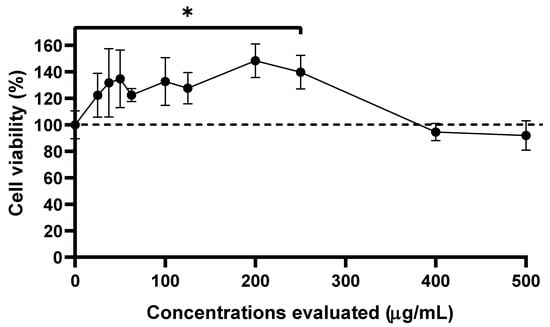
Figure 1
Open AccessReview
Roles of Macrophage Migration Inhibitory Factor (MIF) Signaling Pathway in Oncovirus Infection and Virus-Associated Cancers
by
Jiaojiao Fan, Victor Ryu, Zhiqiang Qin and Lu Dai
Viruses 2025, 17(12), 1582; https://doi.org/10.3390/v17121582 - 5 Dec 2025
Abstract
Approximately 12% of all human cancers are caused by oncoviruses. Macrophage migration inhibitory factor (MIF) signaling activation has been found closely related to many cancer cell malignant behaviors and infectious disease progression. However, its role in virus-associated cancers or how oncoviruses may regulate
[...] Read more.
Approximately 12% of all human cancers are caused by oncoviruses. Macrophage migration inhibitory factor (MIF) signaling activation has been found closely related to many cancer cell malignant behaviors and infectious disease progression. However, its role in virus-associated cancers or how oncoviruses may regulate MIF signaling activities remains largely unknown. In the current review, we summarize recent findings about the oncovirus activation of MIF signaling pathways, their functional roles in viral oncogenesis, and the development of MIF-targeted therapies. We also discuss future directions in this interesting field.
Full article
(This article belongs to the Special Issue Molecular and Cellular Biology of Human Oncogenic Viruses: 2nd Edition)
►▼
Show Figures
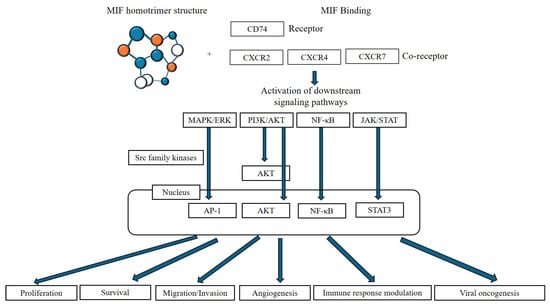
Figure 1
Open AccessArticle
Defining and Predicting HIV Immunological Non-Response: A Multi-Definition Analysis from an Indonesian Cohort
by
Brian Eka Rachman, Yehuda Tri Nugroho Supranoto, Soraya Isfandiary Iskandar, Tri Pudy Asmarawati, Siti Qamariyah Khairunisa, Muhammad Vitanata Arfijanto, Usman Hadi, Muhammad Miftahussurur, Nasronudin Nasronudin, Masanori Kameoka, Retno Pudji Rahayu and Afif Nurul Hidayati
Viruses 2025, 17(12), 1581; https://doi.org/10.3390/v17121581 - 4 Dec 2025
Abstract
Immunological non-response (INR) to antiretroviral therapy (ART) is a critical concern for PLHIV, characterized by inadequate CD4+ T-cell recovery despite virological suppression. This retrospective study analyzed medical records of virologically suppressed adult PLHIV on ART (2004–2024) at two hospitals in Surabaya, Indonesia,
[...] Read more.
Immunological non-response (INR) to antiretroviral therapy (ART) is a critical concern for PLHIV, characterized by inadequate CD4+ T-cell recovery despite virological suppression. This retrospective study analyzed medical records of virologically suppressed adult PLHIV on ART (2004–2024) at two hospitals in Surabaya, Indonesia, using four operational categories to identify clinical and demographic determinants of INR. Patients were classified as immunological responders (IRs) or non-responders (INRs) based on four definitions: INR1 (CD4+ gain < 100 cells/mm3), INR2 (CD4+ < 350 cells/mm3), INR3 (meeting of either criterion), and INR4 (meeting of both criteria). Of 464 patients, 382 were analyzed. Baseline CD4+ < 200 cells/mm3 strongly predicted INR2 (aOR = 5.60, 95% CI: 2.95–10.62) and INR3 (aOR = 4.46, 95% CI: 2.39–8.29), while anal sexual transmission was protective against INR2 (aOR = 0.42, 95% CI: 0.19–0.92) and INR3 (aOR = 0.41, 95% CI: 0.19–0.89). By month 12, IR groups had over 350 CD4+ cells/mm3, with faster recovery slopes in months 0–6 (IR: >20 vs. INR: <10 cells/mm3/month). INR1 and INR4 had flat or negative slopes at 12–24 months, while IR groups had positive slopes. Baseline CD4+ was the strongest INR predictor, suggesting the value of early ART and individualized care for Indonesian PLHIV.
Full article
(This article belongs to the Special Issue Cascade of Care for HIV, Hepatitis and Sexually Transmitted Infections)
►▼
Show Figures

Figure 1
Open AccessCorrection
Correction: Sachse et al. From Entry to Outbreak in a High School Setting: Clinical and Wastewater Surveillance of a Rare SARS-CoV-2 Variant. Viruses 2025, 17, 477
by
Sven Sachse, Ivana Kraiselburd, Olympia Evdoxia Anastasiou, Carina Elsner, Sarah Christina Goretzki, Stefan Goer, Michael Koldehoff, Alexander Thomas, Jens Schoth, Sebastian Voigt, Rudolf Stefan Ross, Ulf Dittmer, Folker Meyer and Ricarda Maria Schmithausen
Viruses 2025, 17(12), 1580; https://doi.org/10.3390/v17121580 - 4 Dec 2025
Abstract
In the original publication [...]
Full article
(This article belongs to the Section Coronaviruses)
Open AccessArticle
Development and Application of a Rapid Field Detection Technology for DENV-2 Based on the HUDSON Nucleic Acid Extraction-Free/RT-RAA/CRISPR-Cas12a System
by
Chang Tan, Siyu Xing, Xiaoxue Xie, Xiaoli Chen, Xiaohui Liu, Wenhao Wang, Lifang Liu, Xinyu Zhou, Jiahong Wu and Chunxiao Li
Viruses 2025, 17(12), 1579; https://doi.org/10.3390/v17121579 - 2 Dec 2025
Abstract
Dengue fever has become a major global public health challenge due to its rapidly in-creasing incidence. Rapid on-site detection of dengue virus (DENV) is critical for early diagnosis, timely patient isolation, and outbreak control. In this study, dengue virus serotype 2 (DENV-2), the
[...] Read more.
Dengue fever has become a major global public health challenge due to its rapidly in-creasing incidence. Rapid on-site detection of dengue virus (DENV) is critical for early diagnosis, timely patient isolation, and outbreak control. In this study, dengue virus serotype 2 (DENV-2), the predominant strain circulating in tropical and subtropical regions, was selected as the target pathogen. We established a one-tube rapid detection assay that integrates the HUDSON nucleic acid extraction-free protocol, reverse transcription recombinase-aided amplification (RT-RAA), and CRISPR/Cas12a-mediated trans cleavage activity. The method achieved a detection limit of 1 × 102 copies/μL for simulated infected samples and exhibited no cross-reactivity with other DENV serotypes (DENV-1, DENV-3, DENV-4) or with other arboviruses, including Zika, Japanese encephalitis, yellow fever, and chikungunya viruses. The assay demonstrated high sensitivity and specificity across various sample types, including mosquitoes, rodents, blood, and cultured cells, with results consistent with quantitative PCR (qPCR). Requiring only basic equipment such as a water bath, the system enables on-site detection of DENV-2 within 1 h. This simple, cost-effective, and reliable assay provides a practical tool for field-based DENV-2 surveillance and supports effective public health responses in resource-limited settings.
Full article
(This article belongs to the Section General Virology)
►▼
Show Figures
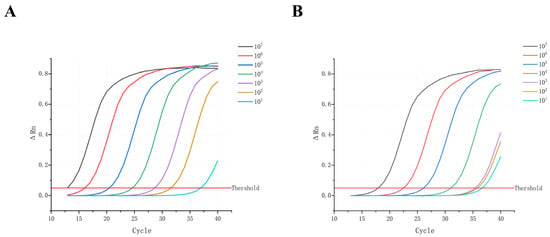
Figure 1
Open AccessArticle
Development of a Novel Virus-Like Particle-Based Vaccine Against PRV-1 Suitable for DIVA Strategies
by
Claudia Galleguillos-Becerra, Matias Cardenas, Yesseny Vásquez-Martínez, Francisca Tapia, Zulema Yañez, Tomas Cancino, Iván Valdés and Marcelo Cortez-San Martín
Viruses 2025, 17(12), 1578; https://doi.org/10.3390/v17121578 - 2 Dec 2025
Abstract
Piscine orthoreovirus genotype 1 (PRV-1) is an emerging viral pathogen in salmon aquaculture that causes Heart and Skeletal Muscle Inflammation (HSMI), with high prevalence in salmon-producing countries such as Chile. A significant obstacle in PRV-1 vaccine development is the inability to culture the
[...] Read more.
Piscine orthoreovirus genotype 1 (PRV-1) is an emerging viral pathogen in salmon aquaculture that causes Heart and Skeletal Muscle Inflammation (HSMI), with high prevalence in salmon-producing countries such as Chile. A significant obstacle in PRV-1 vaccine development is the inability to culture the virus in vitro, which limits the scalability and production of traditional inactivated or DNA-based vaccine strategies. This study describes the development of a novel virus-like particle (VLP)-based vaccine against PRV-1. Recombinant VLP were produced by co-expressing the six structural proteins of PRV-1 (λ1, λ2, μ1, σ1, σ2, σ3) using a baculovirus-based expression system in insect cells. In addition, to enable differentiating infected from vaccinated animals (DIVA) strategies, the σ1 protein was modified by adding of a cmyc epitope tag. The results demonstrated that the native VLP vaccine (VLP6n) significantly reduced viral loads in Atlantic salmon challenged with PRV-1. Moreover, in rainbow trout, the cmyc-tagged VLP-like vaccine (VLP6c) elicited a specific antibody response against the cmyc epitope, allowing differentiation between vaccinated and naturally infected fish. Overall, this VLP-based vaccine platform represents a promising strategy for controlling PRV-1 prevalence in salmon-producing counties, supporting the implementation of serological surveillance programs.
Full article
(This article belongs to the Special Issue Viral Pathogenesis and Novel Vaccines for Fish Viruses)
►▼
Show Figures

Figure 1
Open AccessArticle
Interferons Inhibit Ebola Virus Infection of Human Keratinocytes
by
Jonah Elliff, Hanora Van Ert, Kristina Sevcik, Marija Anne Djurkovic, Danielle Rudd, Francoise Gourronc, Aloysius Klingelhutz, Olena Shtanko and Wendy Maury
Viruses 2025, 17(12), 1577; https://doi.org/10.3390/v17121577 - 2 Dec 2025
Abstract
Orthoebolavirus zairense is the species name for Zaire Ebola virus (EBOV) within Filoviridae. This group of viruses can cause severe disease in humans, characterized by hemorrhagic shock, coagulation abnormalities, and severe inflammation. While tissue macrophages are critical targets early during EBOV infection,
[...] Read more.
Orthoebolavirus zairense is the species name for Zaire Ebola virus (EBOV) within Filoviridae. This group of viruses can cause severe disease in humans, characterized by hemorrhagic shock, coagulation abnormalities, and severe inflammation. While tissue macrophages are critical targets early during EBOV infection, other cell types support viral replication as disease progresses. At late stages of infection, infectious EBOV is found on the surface of the skin, which may be a critical source of infectious virus transmitted between individuals during outbreaks. Human skin contains a number of cellular targets of EBOV, including keratinocytes. Here, we demonstrate EBOV infection of telomerase-immortalized normal human skin keratinocytes (NHSK-1), as well as EBOVΔVP30 infection of NHSK-1 cells that were stably complemented with EBOV transcription factor VP30. Infection with EBOVΔVP30 did not elicit detectable endogenous interferon responses; however, exogenous pre-treatment of NHSK-1 cells with type I, II, and III interferon (IFN) inhibited EBOVΔVP30 infection and infection of an additional low-containment model of EBOV, rVSV/EBOV GP, in a dose-dependent manner. Analysis of the transcriptome of IFN-treated keratinocytes identified multiple genes unique to each IFN and a subset of ISGs upregulated by all three IFNs. Our results indicate that ISGs induced by IFN pre-treatment of keratinocytes can reduce infection, underlining that ISGs may serve as EBOV-targeting therapeutics.
Full article
(This article belongs to the Section Human Virology and Viral Diseases)
►▼
Show Figures
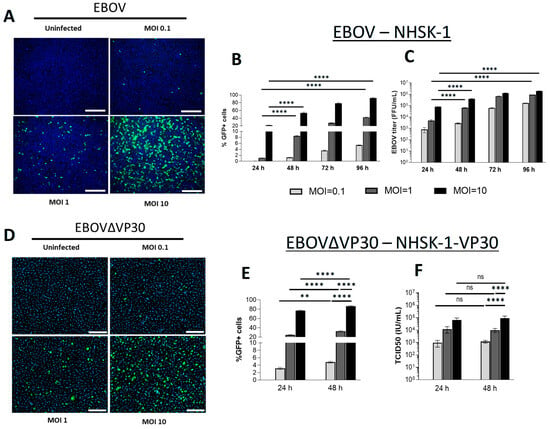
Figure 1
Open AccessArticle
Hepatitis B Virus and Plasmodium falciparum Co-Infection Among Pregnant Women in Gabon: Prevalence, Biochemical Impact, and Antagonistic Replication Dynamics
by
Aude Sandrine Andeme Eyi, Ismaël Pierrick Mikelet Boussoukou, Serge Thierry Omouessi, Jean Alban Ondh Obame, Opheelia Makoyo Komba, Joel Fleury Djoba Siawaya and Bénédicte Ndeboko
Viruses 2025, 17(12), 1576; https://doi.org/10.3390/v17121576 - 2 Dec 2025
Abstract
Background: Hepatitis B virus (HBV) and Plasmodium falciparum infections remain major public health concerns in sub-Saharan Africa, especially among pregnant women, who are particularly vulnerable due to physiological immunomodulation. While mono-infections are well documented, the burden and biological consequences of HBV–P. falciparum
[...] Read more.
Background: Hepatitis B virus (HBV) and Plasmodium falciparum infections remain major public health concerns in sub-Saharan Africa, especially among pregnant women, who are particularly vulnerable due to physiological immunomodulation. While mono-infections are well documented, the burden and biological consequences of HBV–P. falciparum co-infection during pregnancy remain under-investigated in Gabon. Aim: To determine the prevalence, clinical relevance, and biochemical impact of HBV–P. falciparum co-infection among pregnant women in Libreville, Gabon, and to explore the interaction between viral and parasitic replication. Methods: A prospective cross-sectional study was conducted between May 2022 and May 2023 at the CHUME-FJE Laboratory in Libreville. Serum samples were tested for HBsAg using rapid diagnostic tests and ELISA confirmation; HBV surface antigen (HBsAg) levels were quantified by electrochemiluminescence (ECLIA). Parasitemia was assessed by rapid diagnostic test, microscopy, and the Lambaréné thick blood film method. Liver function parameters (ALT, AST, ALP, and GGT) were evaluated using an automated biochemistry analyzer. Statistical analysis included Mann–Whitney U tests, chi-square tests and Spearman’s rank correlation coefficient with significance set at p < 0.05. Results: Of the 222 pregnant women enrolled, HBV infection was detected in 9 cases (4.05%). Among these, 6 (2.7% of the study population) were mono-infected with HBV, while 3 (1.35%) were co-infected with Plasmodium falciparum. P. falciparum parasitemia was detected in 58 cases (26.1%). Biochemical profiles revealed elevated transaminases (AST) in HBV mono-infected women, while liver enzymes remained within normal ranges in co-infected individuals. Quantitative analyses demonstrated an inverse relationship between HBV surface antigen levels and P. falciparum parasitemia. This observation could suggest an antagonistic replication dynamic. However, the relationship was not statistically significant (Spearman’s ρ = −0.5, p = 0.67). Conclusions: HBV and P. falciparum co-infection occurs in a small but clinically relevant proportion of pregnant women in Gabon. The observed inverse replication pattern suggests a potential biological antagonism that may modulate disease severity. These findings although preliminary, could highlight the need for integrated screening and management strategies during pregnancy to improve maternal and fetal outcomes.
Full article
(This article belongs to the Special Issue Viral Hepatitis and Liver Diseases)
►▼
Show Figures
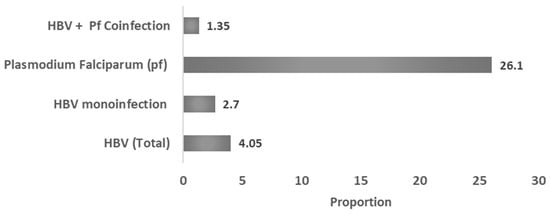
Figure 1
Open AccessArticle
An In Vitro Approach to Evaluate the Impact of Autolysis and Formalin Fixation on the Detection of Canine Distemper Virus and Innate Immune Response Antigens
by
Hannah Gerhards, Karl Rohn, Christina Puff and Wolfgang Baumgärtner
Viruses 2025, 17(12), 1575; https://doi.org/10.3390/v17121575 - 2 Dec 2025
Abstract
Viral infections in humans and animals are increasing, and retrospective studies using formalin-fixed, paraffin-embedded (FFPE) samples reveal recurring outbreaks over past decades. However, the impact of pre-analytical factors like fixation and autolysis on immunohistochemistry (IHC) remains insufficiently understood. To examine how autolysis, fixation
[...] Read more.
Viral infections in humans and animals are increasing, and retrospective studies using formalin-fixed, paraffin-embedded (FFPE) samples reveal recurring outbreaks over past decades. However, the impact of pre-analytical factors like fixation and autolysis on immunohistochemistry (IHC) remains insufficiently understood. To examine how autolysis, fixation duration (6–72 h) and formalin concentration (2.5–25%) influence histology and IHC of canine distemper virus (CDV, Morbillivirus canis), interferon-β (IFN-β), and selected IFN-stimulated genes (ISGs), the study was conducted using an in vitro model based on persistently CDV-infected and non-infected DH82 cells (canine histiocytic sarcoma cell line). Autolysis led to a progressive loss of cell morphology, whereas formalin fixation had minimal impact. CDV nucleoprotein, ISG15, and myxovirus resistance protein (Mx) showed stable immunohistochemical signals across all fixation conditions and remained detectable after prolonged autolysis. CDV infection upregulated ISG15 and Mx. In contrast, IFN-β and phosphorylated protein kinase R (pPKR) exhibited variable staining and did not distinguish infected from non-infected samples. Overall, autolysis had a stronger negative impact on IHC signal quality than fixation parameters. Despite the limitations of the in vitro model, the robustness of CDV, ISG15, and Mx under suboptimal conditions highlights their potential utility as virus-sensing markers in FFPE material.
Full article
(This article belongs to the Section Animal Viruses)
►▼
Show Figures

Figure 1
Open AccessArticle
Burden and Clinical Characteristics of Influenza and Its Complications in Children Across Multiple Epidemic Seasons
by
Arianna Dondi, Fiorentina Guida, Ludovica Trombetta, Maddalena De Peppo Cocco, Giulia Piccirilli, Laura Andreozzi, Eleonora Battelli, Pasquale Castaldo, Ilaria Corsini, Luca Pierantoni, Martina Franceschiello, Liliana Gabrielli, Monia Gennari, Dalila Periccioli, Tiziana Lazzarotto, Daniele Zama and Marcello Lanari
Viruses 2025, 17(12), 1574; https://doi.org/10.3390/v17121574 - 30 Nov 2025
Abstract
Seasonal influenza is a major cause of morbidity and hospitalization in children, with the potential for severe complications and considerable socioeconomic impact. We conducted a retrospective observational study including 1046 children aged 0–14 years with laboratory-confirmed influenza who accessed the Paediatric Emergency Department
[...] Read more.
Seasonal influenza is a major cause of morbidity and hospitalization in children, with the potential for severe complications and considerable socioeconomic impact. We conducted a retrospective observational study including 1046 children aged 0–14 years with laboratory-confirmed influenza who accessed the Paediatric Emergency Department of a tertiary center in Bologna, Italy, across three consecutive epidemic seasons (2022–2025). While the entire cohort was analysed, particular attention was given to children with severe complications requiring hospitalization, for whom more detailed clinical and laboratory data were available. Overall, 12.3% of patients required hospitalization, and 6.1% experienced complications, most frequently influenza-associated encephalopathy, lower respiratory tract infections and myositis. Influenza A predominated overall (82.0%), except for in the last season, which saw a predominance of influenza B (57.4%), closely associated with myositis and elevated creatine phosphokinase levels. Younger age was consistently associated with increased severity and hospitalization. Intensive care admissions were rare (0.8%), and no deaths were recorded. Our findings suggest that, although influenza is generally self-limiting, younger children are at higher risk of complications. These results highlight the importance of active surveillance, careful monitoring of clinical manifestations and targeted paediatric vaccination strategies to reduce the burden of seasonal influenza.
Full article
(This article belongs to the Section Human Virology and Viral Diseases)
►▼
Show Figures
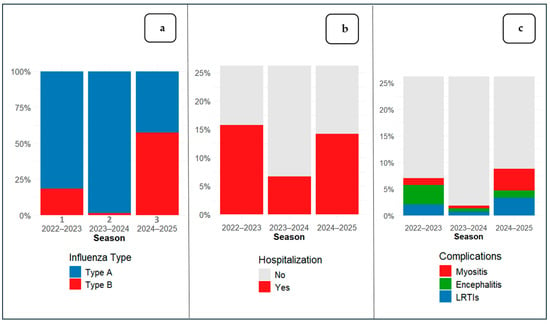
Figure 1
Open AccessReview
Optical Density-Based Methods in Phage Biology: Titering, Lysis Timing, Host Range, and Phage-Resistance Evolution
by
Stephen T. Abedon
Viruses 2025, 17(12), 1573; https://doi.org/10.3390/v17121573 - 30 Nov 2025
Abstract
More than a century ago, bacteriophages (phages) were discovered as entities that could both replicate and dramatically reduce bacterial culture turbidities. By the late 1940s, phage impact on broth turbidity was being studied using electronic detectors. This review examines such turbidimetric, also known
[...] Read more.
More than a century ago, bacteriophages (phages) were discovered as entities that could both replicate and dramatically reduce bacterial culture turbidities. By the late 1940s, phage impact on broth turbidity was being studied using electronic detectors. This review examines such turbidimetric, also known as colorimetric or optical density means of studying phage biology. The focus is especially on relatively rapid and higher throughput phenotypic phage characterization versus methods that rely instead on phage plaques, spots, or genotype determinations. Topics covered include (i) the most probable number method along with Appelmans’ approach, (ii) estimation of phage growth parameters including especially that of phage lysis timing, (iii) consideration of lysis inhibition as a complicating factor, (iv) phage titering based on degrees of optical density change, (v) detection of both lysis from without and resistance to lysis from without, (vi) phage host-range determination, and (vii) study of post-lysis culture grow back, that is, of bacterial evolution of phage resistance. Based on over 30 years of experience using and studying optical density approaches to the exploration of broth-culture phage biology, the author takes a critical look at both the benefits and limitations of this increasingly common approach to phage biological characterization.
Full article
(This article belongs to the Section Bacterial Viruses)
►▼
Show Figures
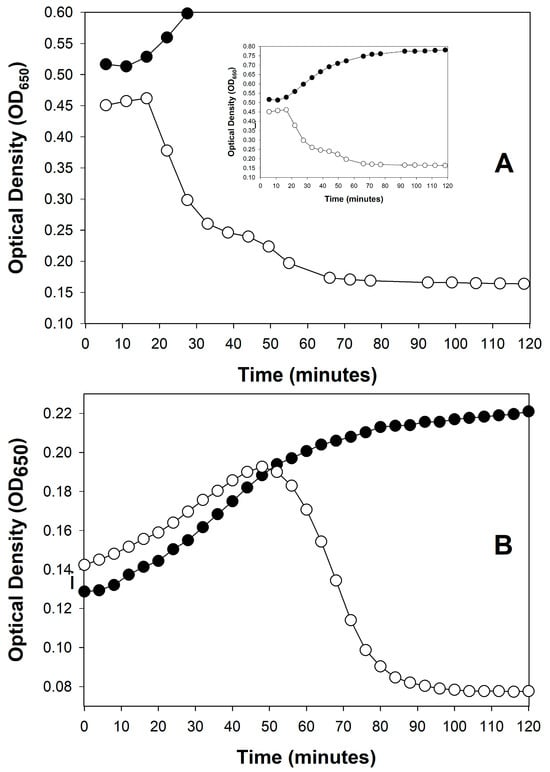
Figure 1
Open AccessArticle
Trends in Norovirus Genotypes in South Korea, 2019–2024: Insights from Nationwide Dual Typing Surveillance
by
Minji Lee, Seung-Rye Cho, Yunhee Jo, Deog-Yong Lee, Myung-Guk Han and Sun-Whan Park
Viruses 2025, 17(12), 1572; https://doi.org/10.3390/v17121572 - 30 Nov 2025
Abstract
Noroviruses are a leading cause of acute gastroenteritis worldwide, with a particularly high burden among children under five years of age. We analyzed nationwide surveillance data from EnterNet-Korea collected between 2019 and 2024—covering both the pre- and post-COVID-19 pandemic periods—to assess norovirus detection
[...] Read more.
Noroviruses are a leading cause of acute gastroenteritis worldwide, with a particularly high burden among children under five years of age. We analyzed nationwide surveillance data from EnterNet-Korea collected between 2019 and 2024—covering both the pre- and post-COVID-19 pandemic periods—to assess norovirus detection rates and genotype distribution. Noroviruses were detected by RT-qPCR, and dual genotyping of capsid (G) and polymerase (P) types was performed by sequencing the ORF1–2 junction region. Among the 67,159 specimens tested, 8.4% (n = 5652) were norovirus-positive, with the highest prevalence observed in children aged 0–5 years (19.9%). In this age group, genotyping was successful in 72.4% (2633/3635) of positive cases, identifying 30 distinct genotypes (GI: 9; GII: 21). The most common strains were GII.4[P31] (38.1%), GII.4[P16] (27.1%), and GII.2[P16] (10.4%), with substantial year-to-year variation. Notably, the emergence of GII.17[P17] in late 2024 indicates shifting genotype dynamics, underscoring the need for strengthened surveillance and reconsideration of vaccine strain selection. To our knowledge, this is the first nationwide dual-typing study in Korea encompassing the COVID-19 pandemic era. These findings provide essential baseline data for integration into global surveillance systems and inform future vaccine development and public health strategies.
Full article
(This article belongs to the Special Issue Viruses Associated with Gastroenteritis)
►▼
Show Figures
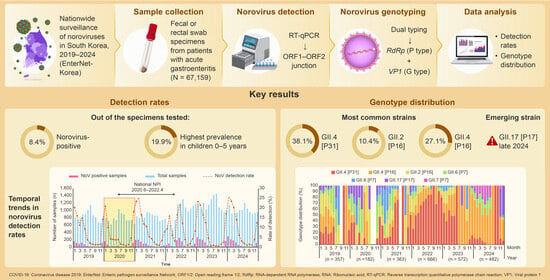
Graphical abstract
Open AccessArticle
Contrasting Evolutionary Dynamics and Global Dissemination of the DNA-A and DNA-B Components of Watermelon Chlorotic Stunt Virus
by
Zafar Iqbal
Viruses 2025, 17(12), 1571; https://doi.org/10.3390/v17121571 - 30 Nov 2025
Abstract
Watermelon chlorotic stunt virus (WmCSV), a bipartite begomovirus, poses a severe and expanding threat to global cucurbit and watermelon production, driving an urgent need to unravel its genetic diversity indices and evolutionary complexities. To elucidate its evolutionary history, this study investigated the genetic
[...] Read more.
Watermelon chlorotic stunt virus (WmCSV), a bipartite begomovirus, poses a severe and expanding threat to global cucurbit and watermelon production, driving an urgent need to unravel its genetic diversity indices and evolutionary complexities. To elucidate its evolutionary history, this study investigated the genetic diversity, evolutionary dynamics, and global dispersal of its genomic components, DNA-A (WmA) and DNA-B (WmB). The analyses uncovered striking contrasts between the components. WmB exhibited markedly greater genetic diversity (π = 0.0508 vs. 0.0119 for WmA), a slightly faster evolutionary rate (1.26 × 10−4 vs. 1.44 × 10−3 substitutions/site/year), and a far more complex recombination profile, with 34 events detected compared to only one in WmA. The abundance of recombination breakpoints in WmB underscores its central role in shaping genomic variability and adaptive potential. Phylogenetic analyses of both components unveil eight robustly supported clades per segment, predominantly shaped by geographical boundaries, hinting at localized evolutionary trajectories with constrained long-distance gene flow, with the exception of Oman. Bayesian time-scaled phylogenies and phylogeographic reconstructions further illuminate distinct dissemination pathways, suggesting an intriguing origin, with WmA likely emerging from the United States and WmB tracing back to Saudi Arabia, while the Middle East emerges as a dynamic epicenter for regional spread and subsequent incursions into the Americas. Together, these findings reveal contrasting evolutionary forces driving WmCSV diversification and provide critical insights into its origins and ongoing global emergence.
Full article
(This article belongs to the Special Issue Plant Virus Spillovers)
►▼
Show Figures
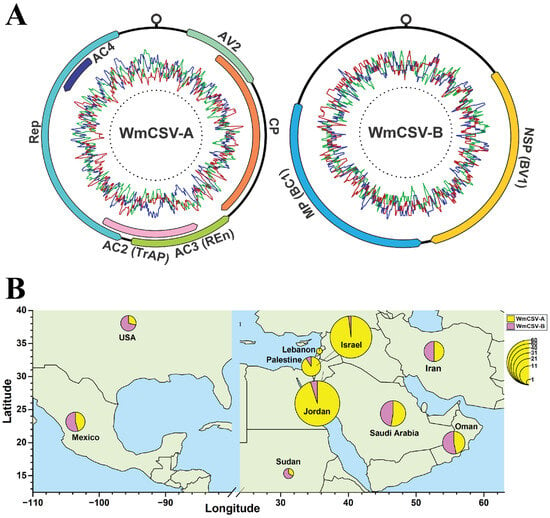
Figure 1

Journal Menu
► ▼ Journal Menu-
- Viruses Home
- Aims & Scope
- Editorial Board
- Reviewer Board
- Topical Advisory Panel
- Instructions for Authors
- Special Issues
- Topics
- Sections & Collections
- Article Processing Charge
- Indexing & Archiving
- Editor’s Choice Articles
- Most Cited & Viewed
- Journal Statistics
- Journal History
- Journal Awards
- Society Collaborations
- Conferences
- Editorial Office
Journal Browser
► ▼ Journal BrowserHighly Accessed Articles
Latest Books
E-Mail Alert
News
Topics

Conferences
Special Issues
Special Issue in
Viruses
Structure-Based Antiviral Drugs and Vaccine Design
Guest Editors: Shi-hua Xiang, Fengwei BaiDeadline: 15 December 2025
Special Issue in
Viruses
Bioinformatics and Computational Approaches in Viral Genomics and Evolution 2025
Guest Editors: Camila Romano, Mariana Severo Ramundo, Nilson CoimbraDeadline: 16 December 2025
Special Issue in
Viruses
Virology in Italy 2025—9th National Congress of the Italian Society for Virology
Guest Editors: Enzo Tramontano, Arnaldo Caruso, Massimiliano Galdiero, Luisa Rubino, Gabriele VaccariDeadline: 20 December 2025
Special Issue in
Viruses
Diversity and Coinfections of Plant or Fungal Viruses, 3rd Edition
Guest Editors: Islam Hamim, Ken Komatsu, Hiromitsu MoriyamaDeadline: 20 December 2025
Topical Collections
Topical Collection in
Viruses
Poxviruses
Collection Editors: Giliane de Souza Trindade, Galileu Barbosa Costa, Flavio Guimaraes da Fonseca
Topical Collection in
Viruses
Efficacy and Safety of Antiviral Therapy
Collection Editors: Giordano Madeddu, Andrea De Vito, Agnese Colpani
Topical Collection in
Viruses
Phage Therapy
Collection Editors: Nina Chanishvili, Jean-Paul Pirnay, Mikael Skurnik





